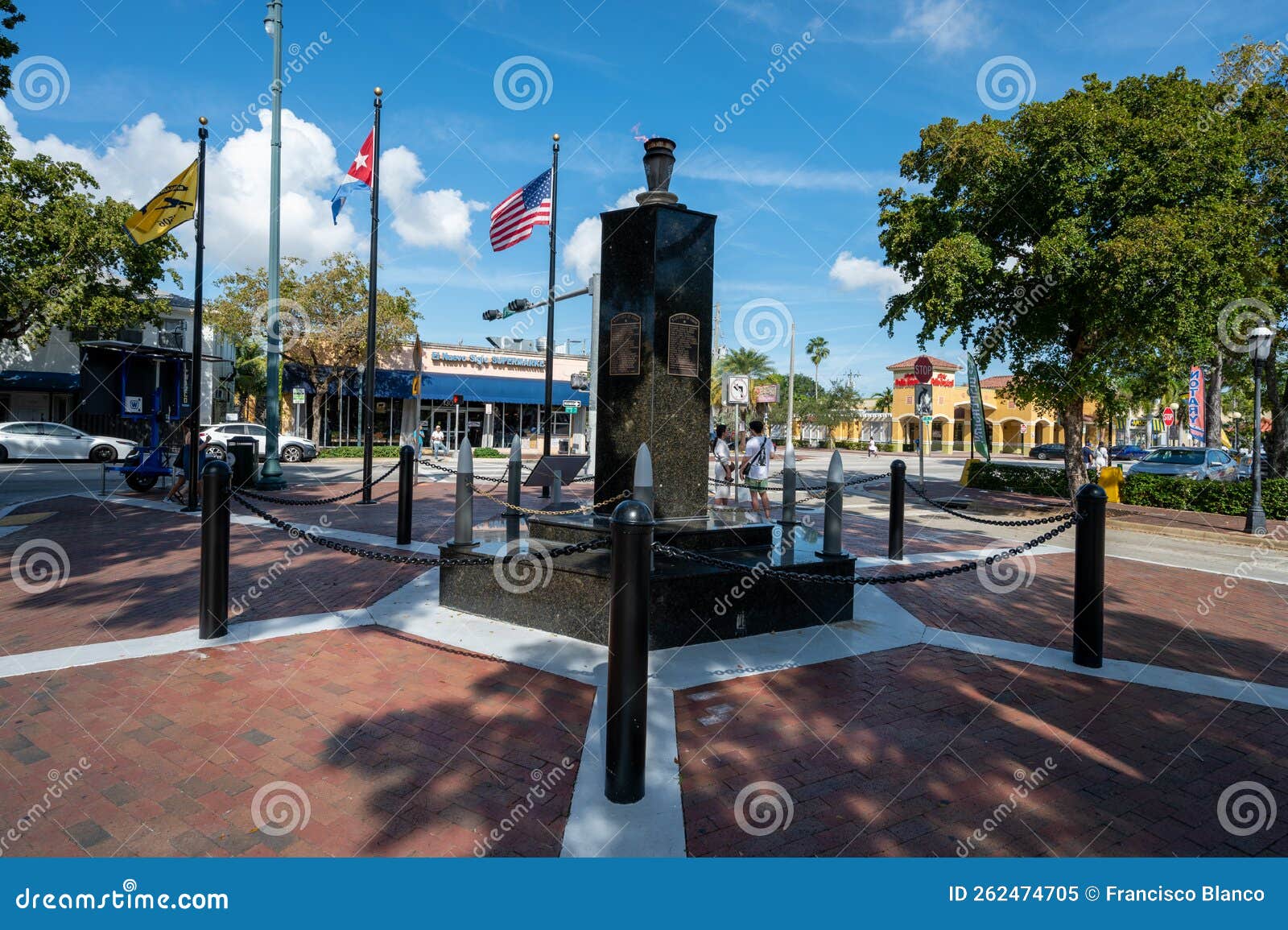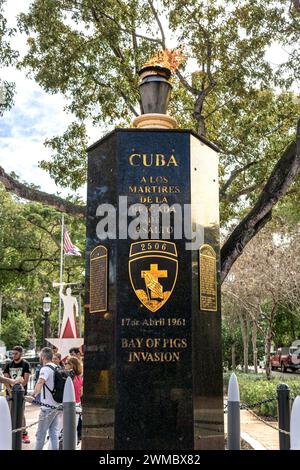Dive into History: Finding Miami's Bay of Pigs Monument Photos With Tourists
Dive into History: Finding Miami's Bay of Pigs Monument Photos With Tourists
Blog Article
Revealing the History of the Bay of Pigs Monolith: An Icon of Conflict and Problem
The Bay of Pigs Monolith stands as a patient tip of a troubled phase in background, shrouded in debate and conflict. Its presence stimulates not just the events that resulted in its development yet also the detailed web of political, social, and worldwide characteristics that proceed to form its story (Bay of Pigs Monument museum). As we peel off back the layers of its beginnings and explore its significance, a complex tapestry of completing analyses and stories arises, providing a glance into the multifaceted nature of historic memory and the enduring influence of past occasions on the present
Origins and Layout of the Monument
The beginnings and style of the Bay of Pigs Monolith can be traced back to a collective effort by popular designers and historians aiming to memorialize a considerable historic event. Situated in Miami, Florida, this monument stands as a testament to the fallen short invasion of Cuba in 1961 by ousted Cuban pressures, backed by the USA government. The style of the monument integrates components that represent the dispute and controversy surrounding the Bay of Pigs invasion, such as a main sculpture depicting the clash between Cuban expatriations and Cuban innovative forces.
Architecturally, the monolith includes a blend of symbolic and modernist layout elements, showing the intricacies of the historic event it celebrates. The option of products, consisting of concrete and steel, not only guarantees the monolith's resilience however likewise includes a feeling of gravitas to the framework. Through its layout, the Bay of Pigs Monument works as a sad suggestion of the consequences of failed armed forces interventions and the long-lasting influence of political choices on both a nationwide and international scale.
Importance in Cuban History
Symbolizing a critical moment in the partnership between Cuba and the United States, the Bay of Pigs Monument holds significant historical significance in Cuban history. The monolith functions as an austere tip of the stopped working invasion by CIA-backed Cuban expatriations in April 1961, targeted at toppling Fidel Castro's routine. This event marked a transforming point in the Cold War, highlighting the stress between both nations and solidifying Cuba's position as a socialist state aligned with the Soviet Union.
The Bay of Pigs intrusion not only showed the United States' efforts to threaten a sovereign country yet likewise showcased Cuba's strength and determination to defend its innovative perfects - Bay of Pigs Monument photos. The monolith stands as a sign of Cuban nationalism and a testimony to the nation's capacity to stand up to foreign intervention. Furthermore, it functions as a rallying point for Cuban satisfaction and unity, memorializing the sacrifices made in protection of their self-reliance and sovereignty. As such, the Bay of Pigs Monolith continues to be a touching symbol of defiance and national identification in Cuban history.

Debates Surrounding Its Construction
Among the preparation and implementation of the Bay of Pigs Monument, a number of debates surfaced regarding its construction procedure. Doubters suggested that putting the monument near the actual Bay of Pigs invasion site would certainly proclaim a dark chapter in Cuban history.
Additionally, the choice of the monument's design also ran the gauntlet. Some suggested that the selected design did not efficiently capture the complexities of the Bay of Pigs intrusion and its results. There were require an extra nuanced and inclusive design that would certainly show the diverse perspectives and experiences associated with the historical occasion.
Moreover, the financing sources for the monolith increased eyebrows amongst the public. Inquiries were increased about the openness of funding and whether any kind of political programs were influencing the building and construction process. Overall, these conflicts highlighted the difficulties of hallowing historical occasions that stay delicate and contentious.
Influence On International Relations

In Addition, the Bay of Pigs Monolith has not only impacted US-Cuban relationships yet has also resonated with various other nations, specifically those with historical ties to the Cold War. The monument represents a considerable minute in background that proceeds to form international dynamics article source and understandings. Therefore, it has actually come to be an example for assessing previous conflicts and their enduring impact on global diplomacy. The ongoing presence of the monument serves as a poignant reminder of the complexities inherent in international relations and the lasting effects of historical events on polite discussion.
Legacy and Ongoing Debates
The enduring legacy of the Bay of Pigs Monument proceeds to trigger ongoing arguments amongst historians, policymakers, and the public, shaping modern discourse on Cold Battle background and diplomatic connections. The monument, erected to commemorate the fallen short intrusion of Cuba by U.S.-backed Cuban exiles in 1961, stands as a suggestion of the intricacies and consequences of concealed armed forces interventions. Chroniclers dispute the extent to which the Bay of Pigs intrusion influenced subsequent united state foreign plan decisions and its influence on Latin American connections.
Policymakers continue to face the lessons gained from the Bay of Pigs fiasco, considering its ramifications for modern-day treatments and the significance of openness in decision-making processes - Bay of Pigs Monument tour. The general public, both in the USA and Cuba, shows on the monolith as a sign of conflicting stories and the divergent point of views bordering historical events. As the monolith stands as a physical depiction of a turbulent period in Cold War background, the recurring disputes it ignites serve as a suggestion of the complexities intrinsic in browsing international connections and the withstanding heritage of past actions

Conclusion
Finally, the Bay of Pigs monolith stands as a symbol of dispute and conflict, showing a complicated background of political tensions and global relationships. Regardless of its origins and design, the monument has actually triggered ongoing arguments and continues to be a controversial topic in Cuban history. Its importance depends on its ability to provoke discussion and reflection on the events surrounding the stopped working intrusion, forming assumptions and analyses of this turning point in background.
The Bay of Pigs Monolith stands as a patient reminder of a tumultuous phase in background, shrouded in conflict and problem.Signifying a pivotal moment in the relationship in between Cuba and the United States, the Bay of Pigs Monolith holds substantial historic value in Cuban history. The Bay of Pigs Monument remains a poignant symbol of defiance and nationwide identification in Cuban history.
Movie critics argued that placing the monolith near the real Bay of Pigs invasion site would proclaim a dark phase in Cuban history.In conclusion, the Bay of Pigs monolith stands as a symbol of dispute and conflict, mirroring a complicated history of global connections and political tensions.
Please visit one of our local supporters - Miami Pool Service Pros Pool Cleaning Service
Report this page